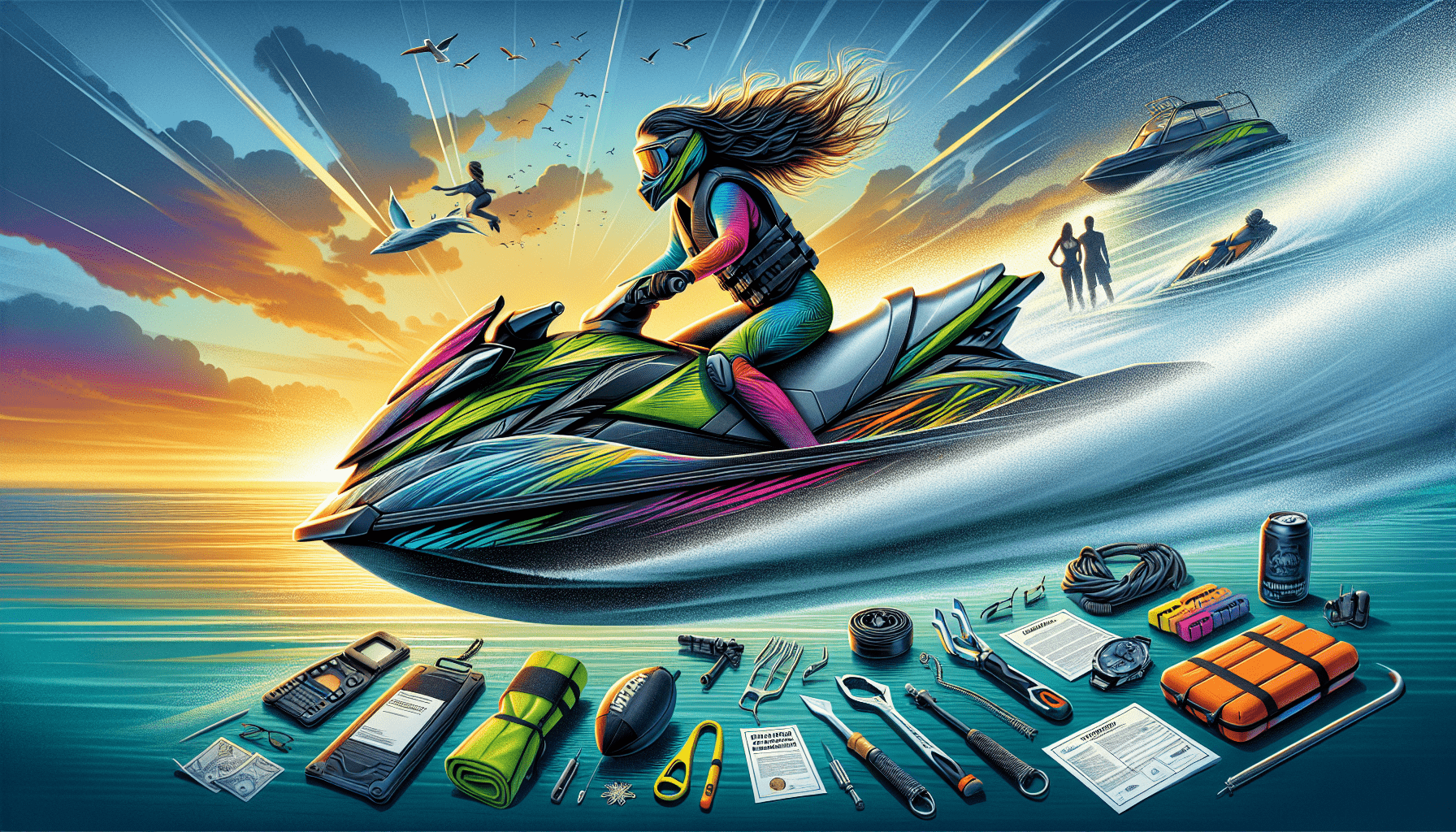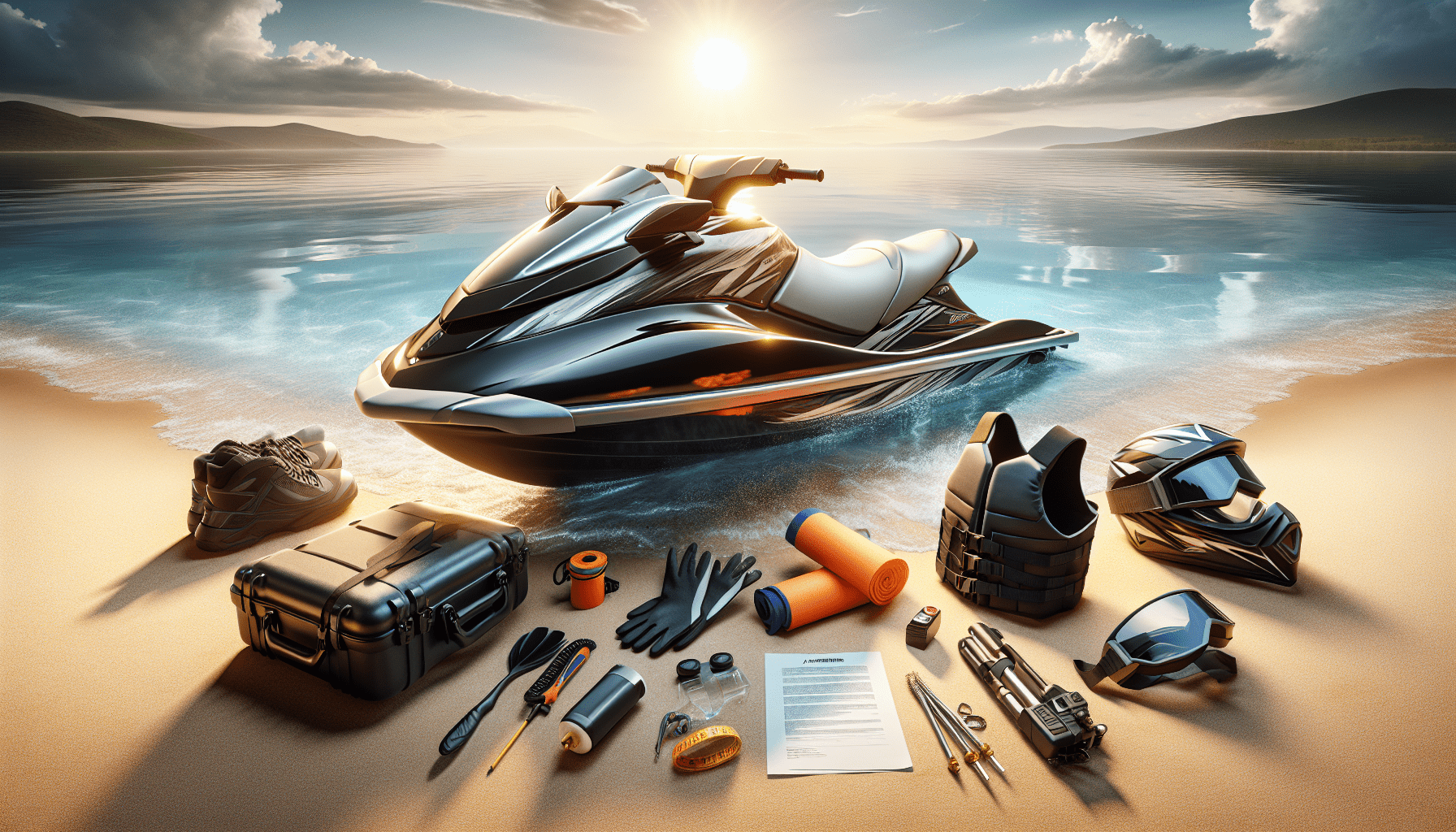What Do You Need To Own A Jet Ski?

If you’ve ever dreamed of feeling the wind in your hair as you glide across the water on a Jet Ski, then you’re probably wondering what it takes to actually own one. Look no further than A2Z Powersport, the go-to company that is an expert in all things Jet Ski and the industry. Located at the stunning Fort Morgan Marina in Orange Beach, Alabama, A2Z Powersport is the perfect place to fulfill your Jet Ski dreams. Whether you’re a seasoned enthusiast or a beginner looking to try this exhilarating water sport, renting a Jet Ski from A2Z Powersport is the ideal option. So, what do you need to own a Jet Ski? Let’s find out.
Required Documentation
Boating License
Before you can take your new jet ski out on the water, it’s important to have the necessary documentation. One of the most crucial pieces of documentation you will need is a boating license. This license shows that you have the knowledge and skills necessary to operate a jet ski safely. Depending on where you live, the requirements for obtaining a boating license may vary. In some areas, a simple written test may be sufficient, while in others, you may need to complete a boating safety course. Make sure to check with your local authorities to determine the specific requirements in your area.
Registration and Title
Just like with a car, your jet ski will also need to be registered and have a title. This process typically involves providing the necessary paperwork, such as proof of ownership and proof of insurance, to your local department of motor vehicles. They will then issue you a registration number and provide you with a title for your jet ski. This registration and title not only legally establish you as the owner of the watercraft but also help in case of theft or damage.
Safety Equipment
Life Jacket
Safety should always be your top priority when enjoying your jet ski. One of the most important pieces of safety equipment you will need is a properly fitting life jacket. A life jacket is designed to keep you afloat in the water and can be a lifesaver in case of an accident or emergency. Make sure to choose a life jacket that is specifically designed for jet skiing or other water sports and meets all the necessary safety standards. It’s also important to ensure that the life jacket fits snugly and is comfortable to wear for extended periods.
Emergency Whistle
In addition to a life jacket, it’s also important to have an emergency whistle on board your jet ski. This simple device can be incredibly useful for attracting attention in case of an emergency or if you need assistance. The sound of a whistle carries far over the water and can alert nearby boaters or rescue personnel to your location. Make sure to keep the emergency whistle easily accessible, such as attached to your life jacket, so that you can quickly and easily use it if needed.
Fire Extinguisher
While not a common occurrence, fires can happen on a jet ski. That’s why it’s essential to have a fire extinguisher on board as part of your safety equipment. A fire extinguisher specifically designed for marine use will be compact and easy to use in case of an emergency. Make sure to check the expiration date on your fire extinguisher regularly and replace it when necessary to ensure it will be effective if needed.
Anchor
Having an anchor on board your jet ski can be useful in certain situations. It allows you to secure your jet ski in one place, whether for fishing, taking a break, or waiting for assistance. When choosing an anchor, make sure it is appropriate for the size and weight of your jet ski and the type of water conditions you will be encountering. It’s also important to have a strong rope or chain to attach the anchor securely and ensure it won’t drift away.
Tow Rope
If you plan on doing any towing activities, such as pulling a tube or water skiing, you will need a tow rope. A sturdy and durable tow rope specifically designed for jet skiing will be able to handle the weight and forces involved in these activities. Make sure to check the weight and length limits of the tow rope and choose one that fits your needs. Additionally, always follow safe towing practices and be aware of the limitations of your jet ski.
First Aid Kit
Accidents and injuries can happen even on the water, so it’s important to have a well-stocked first aid kit on your jet ski. This kit should include basic supplies such as bandages, antiseptic ointment, gauze, adhesive tape, and pain relievers. It’s also a good idea to include any necessary medication or specific items for any pre-existing medical conditions. Keep the first aid kit in a waterproof container to protect it from the elements and make sure all items are in good condition and not expired.
Maintenance Tools
Jet Ski Cover
To protect your jet ski from the elements and prevent damage, a jet ski cover is essential. A good-quality cover will shield your jet ski from rain, sun, dust, and debris, helping to keep it in prime condition. Make sure to choose a cover that is specifically designed for your jet ski model to ensure a proper fit and maximum protection. When using the cover, make sure it is securely fastened to prevent it from coming loose or blowing away in strong winds.
Trailer or Dolly
Transporting your jet ski can be made much easier with the help of a trailer or dolly. A trailer allows you to securely tow your jet ski behind your vehicle, while a dolly provides a convenient way to move your jet ski on land. When choosing a trailer or dolly, make sure it is designed for the size and weight of your jet ski and is equipped with all necessary safety features, such as lights and secure tie-down points. Always follow the proper procedures for loading and securing your jet ski to ensure safe transportation.
Fuel Canister
Having a dedicated fuel canister for your jet ski is a good idea for a couple of reasons. Firstly, it allows you to transport fuel separately from your vehicle, reducing the risk of spills or leaks. Secondly, it provides a convenient way to refuel your jet ski when you’re out on the water. Make sure to choose a fuel canister that is specifically designed for marine use and meets all safety requirements. Always handle fuel with care and follow local regulations regarding refueling practices.
Maintenance Kit
Regular maintenance is crucial for keeping your jet ski running smoothly and extending its lifespan. A maintenance kit that includes essential tools such as wrenches, screwdrivers, spark plug socket, and other common tools will help you perform routine maintenance tasks. Additionally, it’s a good idea to have spare parts on hand, such as spark plugs and oil filters, so you can quickly replace any worn or damaged components. Regular maintenance and inspections will ensure that your jet ski is always in top working condition.
Battery Charger
To prevent your jet ski’s battery from dying and to ensure it’s always ready to go, a battery charger is a must-have. A charger specifically designed for marine batteries will provide the necessary charging power without damaging the battery. It’s important to follow the manufacturer’s instructions and recommendations for charging your battery to avoid overcharging or undercharging. Regularly charging your battery will not only keep it in good condition but also prevent any potential issues when starting your jet ski.
Storage Options
Marina Dock or Slip
If you’re a lucky owner of a jet ski, you will need a place to store it when it’s not in use. One popular storage option is a marina dock or slip. This allows you to keep your jet ski conveniently located near the water, making it easy to launch whenever you want to go for a ride. Marina docks and slips often come with added benefits such as security, access to facilities, and a community of fellow boaters. Make sure to inquire about availability and any specific requirements or fees associated with using a marina dock or slip.
Boat Lift
A boat lift is another excellent option for storing your jet ski. This system lifts your jet ski out of the water, keeping it safe from damage caused by waves, algae, or barnacles. A boat lift allows you to easily access your jet ski without having to launch it every time you want to use it. It also helps to keep the hull and engine clean by preventing the growth of marine organisms. When choosing a boat lift, make sure it is suitable for the weight and size of your jet ski and is easy to operate.
Jet Ski Dock
For those who prefer to keep their jet ski on the water, a jet ski dock is a great storage option. These docks are specifically designed to securely hold your jet ski, keeping it afloat and protected from the elements. Jet ski docks are easy to install and provide a convenient way to access your watercraft whenever you’re ready for some fun on the water. Consider the location and water conditions of your desired installation area when choosing a jet ski dock to ensure it will provide the stability and protection you need.
Transportation
Trailer Hitch
When it comes to transporting your jet ski, a sturdy and reliable trailer hitch is essential. The trailer hitch connects your trailer or dolly to your vehicle, allowing you to tow your jet ski safely. Make sure to choose a trailer hitch that is compatible with your vehicle’s towing capacity and is designed for the weight and size of your jet ski. Always follow the manufacturer’s instructions for installation and use, and regularly inspect your trailer hitch to ensure it is in good condition.
Tie-Down Straps
To secure your jet ski to the trailer or dolly, you will need high-quality tie-down straps. These straps will keep your jet ski firmly in place while you’re on the road, preventing any unnecessary movement or shifting. Make sure to choose straps that are specifically designed for marine use and are capable of handling the weight and forces involved in towing. Always double-check that the tie-down straps are tight and secure before hitting the road to ensure the safe transportation of your jet ski.
Insurance
Liability Insurance
Protecting yourself and others is important when it comes to jet skiing. Liability insurance is designed to cover any damages or injuries that may occur as a result of your jet ski’s use. This type of insurance will typically cover things like property damage, bodily injury, and legal expenses. It’s important to check with your insurance provider to ensure that your liability insurance provides sufficient coverage for your specific needs and any local regulations or requirements.
Comprehensive Insurance
In addition to liability insurance, it’s also wise to consider comprehensive insurance for your jet ski. Comprehensive insurance offers coverage for things like theft, vandalism, and damage caused by natural disasters or accidents. This type of insurance provides additional peace of mind knowing that you are protected against a variety of potential risks. When choosing comprehensive insurance, make sure to carefully review the coverage options and exclusions to ensure you are adequately protected.
Accessories
Docking Lines
Docking lines are an essential accessory for any jet ski owner. These strong and durable ropes are used to secure your jet ski to a dock or slip, preventing accidental drifting or damage caused by waves or currents. It’s important to choose docking lines that are specifically designed for marine use and are able to withstand the forces and stresses of securing your jet ski. Make sure to have an appropriate number of docking lines for your desired docking configuration and regularly inspect them for any signs of wear or damage.
Bumpers
To protect your jet ski from collisions and bumps, it’s a good idea to have bumpers or fenders on board. These inflatable or foam-filled cushions can be placed along the sides of your jet ski to absorb impacts and prevent damage to the hull. When choosing bumpers, make sure they are compatible with your jet ski model and are designed to withstand the elements and frequent use in a marine environment. Regularly inspect your bumpers for any leaks or signs of wear and replace them as needed to ensure continued protection.
Goggles
Protecting your eyes from sun glare, wind, and water spray is crucial when riding a jet ski. A good pair of goggles specifically designed for water sports can make a significant difference in your riding experience. Look for goggles that provide UV protection, a secure fit, and a comfortable seal to prevent water from entering your eyes. Additionally, goggles with anti-fog coating or ventilation systems will help maintain clear vision even in challenging conditions.
Wetsuit
Depending on the water temperature and weather conditions, a wetsuit may be necessary to keep you comfortable and safe while jet skiing. A wetsuit helps to insulate your body by trapping a thin layer of water between your skin and the suit, which then warms up and provides thermal protection. When choosing a wetsuit, make sure it fits snugly but allows for freedom of movement. Consider the thickness and material of the suit based on the water temperature and your personal preferences.
Lanyard
A lanyard is a small but crucial accessory that can prevent accidents and ensure your safety while operating a jet ski. This simple device is attached to your wrist or life jacket and is connected to the jet ski’s engine kill switch. If you were to fall off or become separated from the jet ski, the lanyard will automatically detach from the kill switch, cutting off the engine and preventing the jet ski from becoming a runaway vessel. Always make sure to attach the lanyard properly before starting the engine and wear it whenever you’re riding your jet ski.
Fuel and Oil
Gasoline Canister
To fuel up your jet ski, you will need a dedicated gasoline canister. It’s important to have a separate canister specifically for your jet ski to avoid any cross-contamination or mixing with other fuels. Choose a gasoline canister that meets all safety requirements and is designed for marine use. Make sure to handle gasoline with care and always follow safe practices for refueling, such as avoiding spills and keeping away from open flames.
Oil for 2-Stroke Engine
If your jet ski is equipped with a 2-stroke engine, you will need to have the appropriate oil on hand for regular maintenance. 2-stroke engines require oil to be mixed with the gasoline to provide lubrication and minimize friction. Make sure to check the manufacturer’s recommendations for the correct type and ratio of oil to use in your jet ski’s engine. Regularly check the oil levels and top up as necessary to ensure optimal engine performance.
Maintenance
Cleaning Supplies
Regular cleaning is an essential part of jet ski maintenance. Having the right cleaning supplies on hand will make this task easier and ensure that your jet ski remains in top condition. Some basic cleaning supplies to consider include a non-abrasive boat soap, soft-bristle brushes, microfiber cloths, and a hose with a sprayer attachment. It’s important to avoid using harsh chemicals or abrasive cleaners that can damage the hull or other components. Regularly cleaning your jet ski will remove dirt, salt, and other contaminants that could cause corrosion or affect performance.
Engine Flush Kit
To keep your jet ski’s engine running smoothly, an engine flush kit is a valuable tool. This kit allows you to remove any salt, debris, or other contaminants from the cooling system and engine after each use. A typical engine flush kit includes a hose connection and a flushing attachment that fits into the water intake. By running fresh water through the engine, you can flush out any accumulated salt or debris, helping to prevent corrosion and prolong the life of your jet ski’s engine.
Spark Plugs
Regularly inspecting and replacing spark plugs is an important part of jet ski maintenance. Spark plugs provide the necessary spark to ignite the air-fuel mixture in the engine, and worn or dirty plugs can lead to poor performance or even engine damage. Make sure to check the manufacturer’s recommendations for the correct type and gap specifications for your jet ski’s spark plugs. Routinely inspect the plugs for any signs of fouling, such as excessive carbon buildup or electrode wear, and replace them as necessary to maintain optimal engine performance.
Oil Filter
If your jet ski is equipped with an engine that requires oil changes, it’s important to also replace the oil filter regularly. The oil filter helps to capture and remove any impurities or contaminants from the oil, preventing them from circulating through the engine. Make sure to choose a high-quality oil filter that is specifically designed for your jet ski’s engine. Regularly inspect the oil filter for any signs of damage or clogging and replace it during scheduled oil changes to ensure clean oil and optimal engine performance.
Storage and Winterization
Anti-Freeze
If you live in an area with freezing temperatures or plan to store your jet ski during the winter months, using anti-freeze is an important step in winterization. Anti-freeze helps to protect the engine and other components from the damaging effects of freezing water. Make sure to choose an anti-freeze specifically designed for marine engines and follow the manufacturer’s guidelines for proper use and concentration. It’s also important to ensure that all the water has been drained from the engine and cooling system before adding the anti-freeze.
Winterization Kit
To properly prepare your jet ski for the winter months or an extended period of storage, a winterization kit can be extremely helpful. These kits typically include all the necessary products and instructions for properly winterizing your jet ski, such as fuel stabilizer, fogging oil, and anti-corrosion spray. Using a winterization kit will ensure that your jet ski is protected from any potential damage caused by freezing temperatures, moisture, or corrosion. Follow the instructions carefully and perform all the recommended steps to ensure a trouble-free start-up when the next boating season arrives.
Storage Unit
If you don’t have access to a marina dock, boat lift, or other on-water storage options, renting a storage unit can be a great solution for keeping your jet ski safe and protected. Look for a storage unit facility that offers secure and covered storage options specifically designed for boats or recreational vehicles. Make sure the storage unit is large enough to accommodate your jet ski and provides adequate security features, such as surveillance cameras or access control systems. Renting a storage unit will give you peace of mind knowing that your jet ski is stored in a secure and climate-controlled environment.
Owning a jet ski can provide hours of fun and excitement on the water, but it also comes with certain responsibilities. By ensuring you have the required documentation, necessary safety equipment, and appropriate storage and maintenance tools, you can enjoy your jet ski to the fullest while keeping yourself and others safe. Remember to always follow local regulations and best practices for jet ski operation and maintenance. Enjoy your time out on the water and remember to have a blast while staying safe!








